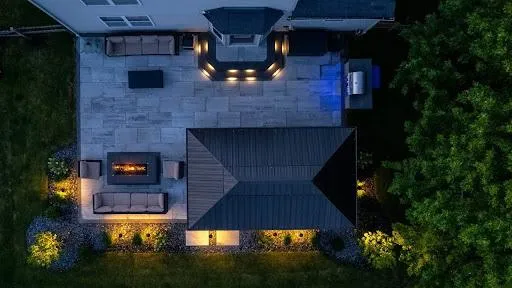Blogs

How Can I Use Outdoor Lighting in My Landscape Design?
Outdoor lighting can significantly enhance your landscape design by highlighting key features and creating a welcoming atmosphere. Use path lights to illuminate walkways and guide guests safely through your garden. Spotlighting can draw attention to trees, sculptures, or architectural elements, adding drama and focus. Install up-lighting to create shadows and textures on walls or plants, which adds depth and interest. String lights or lanterns can provide a cozy and inviting ambiance for outdoor living areas. Additionally, consider using motion sensors for security and practical lighting solutions. Proper placement and the right type of lighting can transform your outdoor space, making it both beautiful and functional.
Outdoor lighting is more than just a practical necessity; it's a powerful tool for enhancing the beauty, safety, and functionality of your landscape design. By incorporating thoughtful lighting strategies, you can transform your outdoor spaces into captivating environments that shine both day and night. From highlighting natural features to guiding guests, the right lighting can elevate your landscape to new heights. At Landscaping Experts Inc, Naperville’s leading premium outdoor living company, we specialize in creating stunning outdoor spaces tailored to your needs. With over 30 years of experience, our team is dedicated to delivering top-notch landscape design solutions that include expertly crafted outdoor lighting plans.
Key Takeaways:
Highlight Natural Features for Drama: Use low-voltage accent lights to illuminate trees, rock walls, and water features for dramatic effects.
Guide Guests with Path Lighting: Strategically place path lights along walkways and patios to ensure safety and enhance the texture of natural stone hardscapes.
Create Ambiance with Layered Lighting: Combine ambient, task, and accent lighting to create a balanced and dynamic effect. Utilize dimmers to adjust the mood.
Blend Artificial Elements: Uplight the side of your home to blend it with the landscape, and use plants or objects to break up visual space.
Consider Energy Efficiency: Opt for energy-efficient LED or solar-powered lights to reduce consumption and costs.
Mastering Outdoor Lighting: Key Strategies to Enhance Your Landscape Design
Highlight Natural Features for Drama
Low-voltage accent lighting is a powerful tool for bringing out the natural beauty of your landscape. By strategically placing these lights, you can emphasize the textures and architectural details of elements such as trees, rock walls, and water features. This type of lighting enhances the visual interest of your outdoor space, making it more dramatic and captivating at night. For a striking effect, consider uplighting trees to create glowing silhouettes, and use underwater lights to illuminate water features, creating a shimmering and sophisticated ambiance.
Uplighting: Cast a glow upwards through tree canopies for dramatic silhouettes.
Rock Lighting: Place lights around large rocks or boulders to enhance their natural contours.
Underwater Lights: Illuminate fountains or ponds to create shimmering effects.
Guide Guests with Path Lighting
Path lighting is essential for ensuring safety and enhancing the aesthetic appeal of your outdoor spaces. Properly placed path lights illuminate walkways and patios, making navigation easier and safer at night. These lights should shine downward to provide clear visibility without causing glare. Additionally, path lighting can highlight the textures of hardscape elements like natural stone, enhancing the overall design of your outdoor area. Choosing fixtures that complement your landscape’s style can further enhance the welcoming atmosphere of your space.
Downward Lighting: Illuminate the edges of paths to reduce tripping hazards.
Fixture Style: Select lights that match your landscape’s design, whether modern or classic.
Texture Highlighting: Enhance the appearance of hardscapes like stone with path lighting.
Create Ambiance with Layered Lighting
Layered lighting involves combining different lighting types to create a well-rounded and inviting atmosphere in your outdoor space. By integrating ambient, task, and accent lighting, you can enhance functionality and visual appeal. Ambient lighting provides general illumination, task lighting focuses on specific areas like outdoor kitchens or seating, and accent lighting highlights particular features such as sculptures or water elements. Adjusting the brightness with dimmers allows you to set the mood for various occasions, making your outdoor area versatile and engaging.
Ambient Lighting: Provides general illumination for overall visibility.
Task Lighting: Focuses on specific areas where activities occur, such as cooking or dining.
Accent Lighting: Highlights features like sculptures, water elements, or architectural details.
Blend Artificial Elements
Blending artificial elements with your landscape design helps create a cohesive look between your home and outdoor space. By using uplighting on the exterior of your home, you can enhance architectural features and seamlessly integrate the building with the surrounding landscape. Adding plants or decorative objects near the home can break up visual space and add layers of texture. This approach improves the overall harmony of your garden and home, making your outdoor environment more inviting and aesthetically pleasing.
Uplighting: Illuminate the home’s exterior to enhance architectural features.
Decorative Objects: Use sculptures, planters, or trellises to add texture and interest.
Integrated Lighting: Combine lighting with plants and objects to blend artificial elements.
Consider Energy Efficiency
Energy efficiency is a crucial aspect of modern outdoor lighting, offering both environmental and cost benefits. By choosing energy-efficient options such as LED or solar-powered lights, you can significantly reduce energy consumption and lower utility costs. LEDs are known for their long lifespan and low electricity use, while solar-powered lights harness the sun’s energy and require no wiring. Both options contribute to a greener environment and help minimize your carbon footprint, making them ideal for sustainable outdoor lighting solutions.
LED Lights: Use less electricity and have a longer lifespan than traditional bulbs.
Solar-Powered Lights: Harness solar energy, require no wiring, and are available in various styles.
Energy Efficiency: Reduces your carbon footprint and lowers utility costs.
Essential Guide to Outdoor Lighting: Choosing Fixtures, Avoiding Mistakes, and Enhancing Your Space
Choosing the Right Outdoor Lighting Fixtures
Selecting the right outdoor lighting fixtures is essential for enhancing both the functionality and aesthetics of your landscape. The variety of fixtures available includes wall-mounted sconces, in-ground lights, path lights, and more, each serving a unique purpose. When choosing fixtures, consider factors such as the type of light output required, the durability of the materials, and how well the fixtures integrate with your overall landscape design. Proper selection ensures that your outdoor lighting not only complements your design but also provides the necessary illumination for safety and enjoyment.
Wall-Mounted Sconces: Ideal for highlighting architectural features and providing classic appeal.
In-Ground Lights: Perfect for illuminating pathways and garden beds.
Path Lights: Enhance visibility and safety along walkways.
Flood Lights: Provide broad illumination for larger areas or security.
Spot Lights: Focus on specific features, like sculptures or trees.
Top 5 Landscape Lighting Mistakes to Avoid
Effective landscape lighting can significantly elevate your outdoor space, but common mistakes can lead to suboptimal results. Over-lighting is a frequent error that can cause glare and detract from the ambiance. Improper placement, such as installing lights too close to walls or under trees, can obstruct light and reduce effectiveness. Failing to consider light pollution and the impact on neighboring properties can also be problematic. To avoid these mistakes, plan your lighting layout thoughtfully, select appropriate fixtures, and ensure that your lighting enhances rather than overwhelms your landscape.
Over-Lighting: Avoid creating glare that diminishes ambiance.
Improper Placement: Position lights correctly to avoid obstruction and maximize effectiveness.
Ignoring Light Pollution: Consider the impact on neighboring areas to prevent excessive light spill.
Inconsistent Design: Ensure that lighting complements rather than clashes with your landscape design.
Neglecting Maintenance: Regularly check and maintain fixtures to ensure optimal performance.
Benefits of Solar-Powered Landscape Lighting
Solar-powered landscape lighting offers a range of benefits that make it a favored choice for environmentally conscious homeowners. These lights capture sunlight during the day and use it to power themselves at night, eliminating the need for electrical wiring and reducing energy costs. They are easy to install, require minimal maintenance, and are available in various styles and brightness levels. Solar lights also contribute to sustainability by utilizing renewable energy. However, their effectiveness can vary based on sunlight exposure, so placing them in well-lit areas is crucial for optimal performance.
No Wiring Needed: Simplifies installation and reduces installation costs.
Energy Efficiency: Lowers energy bills by using renewable solar power.
Minimal Maintenance: Requires less upkeep compared to wired lighting systems.
Variety of Styles: Available in numerous designs to suit different tastes.
Environmental Impact: Contributes to sustainability by using clean energy.
How to Integrate Smart Lighting in Your Landscape Design
Incorporating smart lighting into your landscape design enhances convenience and versatility. Smart lighting systems allow you to control your outdoor lights via smartphone apps or voice commands, offering features such as programmable schedules, remote control, and adjustable brightness. This technology not only improves security but also adds flexibility, enabling you to create custom lighting scenes tailored to various occasions. When selecting a smart lighting system, ensure it integrates well with your existing design and meets your specific needs for functionality and aesthetics.
Programmable Schedules: Set timers for when lights turn on and off.
Remote Control: Adjust lighting from your smartphone or voice-controlled devices.
Adjustable Brightness: Customize light intensity for different moods and occasions.
Enhanced Security: Use smart lighting to improve safety with automated features.
Integration: Choose a system compatible with your current landscape design.
Maintaining Your Outdoor Lighting System
Regular maintenance of your outdoor lighting system is key to ensuring its longevity and optimal performance. Begin by cleaning fixtures and lenses periodically to remove dirt and debris that can impair light output. Inspect for any signs of damage, such as frayed wires or broken bulbs, and replace them as needed. Check the wiring and connections for security and moisture damage. For solar lights, ensure that solar panels are clean and positioned to receive sufficient sunlight. Consistent upkeep preserves the functionality and appearance of your lighting system, keeping your landscape looking its best.
Cleaning Fixtures: Regularly remove dirt and debris to maintain light output.
Inspecting for Damage: Look for frayed wires or broken bulbs and replace them promptly.
Checking Wiring: Ensure connections are secure and free from moisture damage.
Maintaining Solar Panels: Keep solar panels clean and correctly positioned for optimal sunlight exposure.
Routine Upkeep: Follow a maintenance schedule to prolong the life of your lighting system.
FAQs
What types of outdoor lighting are best for highlighting landscape features? Low-voltage accent lights and uplights are ideal for highlighting landscape features such as trees, rock walls, and water features. These lights can create dramatic effects and bring out the textures and architectural details of your landscape elements.
How can path lighting improve safety in my outdoor space? Path lighting helps guide guests safely along walkways and patios by providing illumination that reduces the risk of tripping or stumbling. It also enhances the visual appeal of your outdoor space by highlighting the texture and design of your hardscapes.
What is the difference between ambient, task, and accent lighting? Ambient lighting provides overall illumination for general visibility, task lighting focuses on specific areas where activities occur, and accent lighting highlights particular features or objects for visual interest and drama. Combining these types creates a balanced and functional lighting design.
Are solar-powered lights effective for all outdoor lighting needs? Solar-powered lights are effective for many outdoor lighting needs, such as path lighting and accent lighting. However, their performance can be affected by factors like sunlight exposure and weather conditions. Ensure they are placed in areas with adequate sunlight to function optimally.
How often should I maintain my outdoor lighting system? Regular maintenance should be performed at least twice a year. This includes cleaning fixtures, checking for damage, and inspecting wiring and connections. For solar lights, clean the panels and ensure they are positioned correctly to maximize sunlight exposure.
Illuminate Your Landscape with Landscaping Experts Inc
Transform your outdoor space into a captivating haven with expertly designed outdoor lighting from Landscaping Experts Inc. Our team in Naperville combines creativity and technical expertise to enhance your landscape’s beauty, safety, and functionality.
At Landscaping Experts Inc, we are passionate about creating beautiful and functional outdoor spaces that reflect your style and needs. Don’t wait—reach out to us now for a free estimate and let our team of experts illuminate your property with exceptional design and craftsmanship. Contact us today to get started on your dream outdoor space!

Follow Us
Service Areas
Plainfield
Shorewood
Morris
Lake Forest
Winnetka
Hinsdale
Western Springs
Hinsdale
Service Areas
Wilmette
Northbrook
Montgomery
Deerfield
Saint Charles
Kelinworth
Golf
Campton Hills
Barrington
Hoffman Estates
Copyright © Landscaping Experts Inc. 2024. All Rights Reserved. Privacy Policy. Terms & Conditions. Web Design by Fused Media

